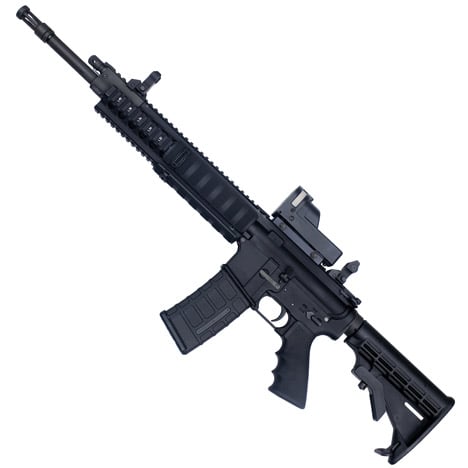
"Frontline soldiers could soon be printing entire weapons or even aircraft"
Following today's news that the first 3D-printed gun has been fired, Dezeen reporter Emilie Chalcraft takes a look at how 3D-printed guns and drones are changing weaponry and warfare in this extract from Print Shift, our one-off publication about 3D printing.
There's a dark side to additive manufacturing. It could transform warfare and put homemade guns in the hands of criminals.
Always quick to find a use for cutting-edge technology, military scientists are deploying 3D printers on the front line to produce everything from gun components to unmanned aircraft. The US Army has been taking the lead, even going so far as to develop its own 3D printer as an alternative to commercial models.
Last July, the first mobile 3D-printing lab arrived in Afghanistan, allowing soldiers to repair their equipment quickly and cheaply, rather than wait weeks for spare parts to be delivered. “We can generate replacement parts with a device small and light enough to be carried in a backpack,” says D. Shannon Berry, an operations research analyst in the US Army’s Space and Missile Defense Command.

Soon, frontline soldiers could be printing entire weapons or even aircraft. Engineers from MITRE, a corporation that carries out research for US government agencies, recently teamed with University of Virginia students to design, print and fly a smartphone-controlled drone, at a cost of just a few thousand dollars.
“I absolutely see 3D-printed drones being the norm in the not-too-distant future,” says University of Sheffield academic Neil Hopkinson, who’s been researching additive manufacturing since the 1990s and believes the military will be one of the first sectors to benefit from the technology. “One of the beauties of additive manufacturing is its diversity of applications. Within the military, I see it being used to make everything from personalised shoe soles to parts for vehicles.”
But if it’s so easy for soldiers to print gun parts, what’s to stop civilians from doing the same? Last year, US hobbyist Michael Guslick attached a 3D-printed plastic lower receiver – the only part of a gun that actually requires a licence in the US – to an AR-15 rifle before firing off 200 test-rounds. Meanwhile libertarian activists Defense Distributed announced plans to disseminate blueprints for a homemade DIY gun. Led by Texan law student Cody Wilson, the group aims to develop a fully printable plastic firearm adapted for basic desktop 3D printers [unveiled this week] and is already sharing files for individual components through its DEFCAD web forum.

The increased accessibility of 3D printing technology is a “double-edged sword”, says Ronen Kadushin, a pioneer of the open-design philosophy, which aims to turn industrial design into a networked community unhindered by ownership and copyright restrictions. “It’s frightening for governments now, because it means the total dissemination of arms into the community. You can print ammunition for your own army.” Kadushin predicts that amateur designers could eventually suffer the same vilification as computer hackers do today. “All you need is one person to make a 3D-printed weapon and kill somebody with it. This is a very dangerous situation.”
Neil Hopkinson is less convinced of the threat posed by hobbyists. “The costs of the equipment, and the levels of skill and expertise you’re going to need, are high,” he says. “Those sorts of things just aren’t going to be accessible to the general public.”
Looking further into the future, Liam Young, co-founder of design and research studio Tomorrow’s Thoughts Today, suggests digital piracy could be an issue for the arms industry in the same way it has been for the entertainment industry. “Black-market economies will turn the illicit arms trade into a 3D-printed supply chain,” he suggests. “And these supply chains are going to be co-opted – not by Apple or Microsoft or whoever owns the digital rights to these weapons, but by organised-crime syndicates.
“It’s going to be complicated and messy,” he continues. “And it’s going to change things fundamentally – but perhaps not in the way we’re expecting.”
Main image: An AR-15 rifle, the weapon US hobbyist Michael Guslick managed to 3D-print a key part for last year, transforming it into a fully functioning firearm